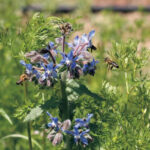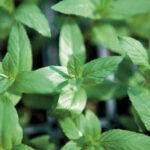<
| Herbs: |
|
Days to Maturity: 56 from direct sow Borage makes strawberries fruit more heavily, keeps hornworms off the tomatoes, and increases yields of cucumbers, gourds, and other fruiting plants. Borage is more than just a pleasant edible herb. It’s a garden guardian, and it belongs in your sunny annual bed as well as the vegetable patch and herb garden. An annual (or biennial) with handsome small blue blooms as well as long, toothy leaves, Borage Seeds grow quickly and self-sows readily. It needs to be direct sown where it is to grow, because it forms a long taproot that does not transplant well. So after you’ve transplanted your tomatoes and set your strawberry runners, drop a few seeds in holes ¼ to ½ inch deep and spaced about a foot apart in full sun. Cover with ½-inch of soil, and within 2 weeks you will see green shoots. Borage flowers in early to midsummer. It is a bee magnet, and seems to repel several types of predatory pests while simultaneously welcoming “good bugs” into the garden. Strawberries are its boon companion, and it has been shown to increase the yields of this fruit. Tomatoes also benefit. This herb self-sows, so if you want to avoid unwanted seedlings in the spring, choose which plants you allow to go to seed. Borage reaches about 2 feet high, with 1½-inch star-shaped blooms of brilliant azure. We didn’t even mention the reason many gardeners grow it: its beautiful ornamental appeal. An all-around must-have for any sunny garden spot. |
|
Days to Maturity: 73 from direct sow No herb or kitchen garden is complete without mint, and peppermint adds a festive note to the display, evoking the holidays and filling the air with its fresh, clean scent when rubbed. Give it a go from seed this season and delight your friends with little peppermint seedlings for the holidays! Strongly aromatic peppermint can be used in both cooking – in drinks, salads, and baked goods – and in potpourri and other fragrant decorative items. In hot tea, it is said to help stomach upset. Peppermint is a perennial, reaching 3 feet tall in the garden (much smaller in pots and indoors), and spreading just as far as you will let it. It offers smooth, lance-shaped 3-inch leaves, bright green with purple tints around the edges. In summer, spikes of lilac-pink flowers top the foliage, attracting bees into the garden. Give it sunshine and good soil drainage; it will do the rest. Like all the mints, peppermint can be invasive. If you want to cover hot, sunny soil, it’s invaluable, but if your space is limited or you want to plant other things nearby, you are much better off confining peppermint to a container. It grows wonderfully, and you will not only have plenty to harvest, but enough to give friends cuttings so that they can start their own mint gardens. Mint is not the easiest seed to sprout, but if you have a Park’s Original Bio Dome Seed-Starting System it’s a walk in the park: drop one seed in each bio sponge, put the dome on, and wait to see green shoots in 7 to 14 days. If you’re using seed flats or another method of germination, here’s the best approach: set one or two seeds in shallow 1/4-inch holes in moist seed-starting mix. Cover the flat with plastic wrap and germinate at 65 degrees Fahrenheit or above. If you are starting the seeds in late winter for transplanting in spring, begin about 6 weeks before last scheduled frost. Peppermint will be ready to pick on an as-needed basis about 3 weeks after transplanting; it grows so quickly that you never have to worry about taking too much, as long as you leave a few green leafy stems on the plant! Harvest all summer and fall. Zone 4 – 9 |
|
Days to Maturity: 75 from direct sow A long-lived evergreen perennial. Introduced to North America in the 17th century, Sage has been used over the centuries for a wide variety of culinary and medicinal purposes. This hardy evergreen shrub is easy to grow and long-lived, a mainstay of the perennial border, herb garden, and containers for the patio and even the home. The aroma is enticing and the flavor fabulous. Be sure to grow plenty in your garden. Many Americans associate sage with Thanksgiving, but this seasoning is useful in a wide range of dishes, from dressings and sausages to cheeses and meats. Try growing your own, and enjoy its superb flavor and aroma—not to mention its attractive appearance—for many seasons in the garden. Sage is a shrubby plant, forming many side branches of velvety-textured, wrinkled, gray-green leaves about 2 inches long. Spikes of 1/2-inch violet, pink to white flowers appear in summer. The plant matures to 24 to 32 inches high and 36 inches wide. Sow seeds at 60 to 70 degrees Fahrenheit. They take about 3 weeks to germinate, but then grow readily and can be transplanted when they have at least 2 sets of true leaves. Grow in well-drained to dry, neutral to alkaline soil in full sun. Pick sage leaves as needed once the plant is growing well and has branched out nicely—75 days is a benchmark, but individual plants will vary depending upon conditions. Stop harvesting in fall, so that the plant can harden off for winter outdoors in the garden or containers. Sage will become woody and leaf out sparsely after about 4 years; at that time, if you are growing it for culinary purposes, it is best to remove the entire plant and begin a new one. Days to Maturity: 75 from direct sow. A long-lived evergreen perennial. Introduced to North America in the 17th century, Sage has been used over the centuries for a wide variety of culinary and medicinal purposes. This hardy evergreen shrub is easy to grow and long-lived, a mainstay of the perennial border, herb garden, and containers for the patio and even the home. The aroma is enticing and the flavor fabulous. Be sure to grow plenty in your garden. Many Americans associate sage with Thanksgiving, but this seasoning is useful in a wide range of dishes, from dressings and sausages to cheeses and meats. Try growing your own, and enjoy its superb flavor and aroma—not to mention its attractive appearance—for many seasons in the garden. Sage is a shrubby plant, forming many side branches of velvety-textured, wrinkled, gray-green leaves about 2 inches long. Spikes of 1/2-inch violet, pink to white flowers appear in summer. The plant matures to 24 to 32 inches high and 36 inches wide. Sow seeds at 60 to 70 degrees Fahrenheit. They take about 3 weeks to germinate, but then grow readily and can be transplanted when they have at least 2 sets of true leaves. Grow in well-drained to dry, neutral to alkaline soil in full sun. Pick sage leaves as needed once the plant is growing well and has branched out nicely—75 days is a benchmark, but individual plants will vary depending upon conditions. Stop harvesting in fall, so that the plant can harden off for winter outdoors in the garden or containers. Sage will become woody and leaf out sparsely after about 4 years; at that time, if you are growing it for culinary purposes, it is best to remove the entire plant and begin a new one. |
|
Flavor: Subtle, delicate parsley flavor. Preparation Ideas: Use as a garnish to add some extra freshness to your dishes! Plant Type: Herb Fill Weight (grams): 1.25 Soak seeds overnight in warm water. Start indoors in a sunny location 6 weeks before planting outdoors. Or, sow in the garden in rich, moist, deep soil in sun or partial shade as early as ground can be worked. Thin or tranpsplant plants to 10 inches apart when they are 2 inches tall. Cut only 2 or 3 stems from a plant as required for use. Planting Depth: .25″ Seed Spacing: 10″ Germination: 21-25 days Height: 12-16″ For later use, freeze leaves or dry them in the shade. Interplant parsley with roses and tomatoes to enhance vigor of both. Soak seeds overnight in warm water to speed germination. |




